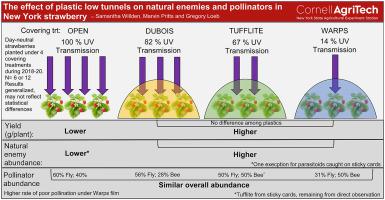Crop Protection ( IF 2.5 ) Pub Date : 2021-09-18 , DOI: 10.1016/j.cropro.2021.105820 Samantha A. Willden 1 , Marvin P. Pritts 2 , Gregory M. Loeb 1

|
Although growing strawberries under low tunnels is increasing in popularity across the northeastern United States, little is known of how they impact the presence of natural enemies and pollinators that provide key ecosystem services on strawberry. We employed passive (fruit collections, sticky cards and pitfall traps) and direct (direct observations, leaf brushing and fruit bagging) monitoring over 2–3 growing seasons to compare the abundance and impact of beneficial insects and mites on strawberry grown under low tunnels versus the open field. Three different low tunnel plastics ranging in UV-selectivity were included to determine any effect of UV exclusion on natural enemy and pollinator presence. Plant yield and fruit marketability was higher under low tunnels compared to the open field for two of three years observed. The abundance of predators, and to a lesser extent parasitoids, was similar or higher under low tunnels compared to the open field. However, catch on sticky cards revealed lower densities of parasitoids under tunnels. There was some evidence that UV-selecting plastics resulted in poorly pollinated fruit compared to UV-transmitting and open-field treatments. However, there was no difference in pollinator presence among treatments, so the mechanisms causing the plastic effect are unclear. Overall, we conclude that growing strawberries under low tunnels, regardless of UV selectively, can support higher and more marketable yield in some years while likely having neutral to positive impacts on beneficial predators, parasitoids and pollinators.
中文翻译:

塑料低隧道对纽约草莓天敌和传粉媒介的影响
尽管在美国东北部的低隧道下种植草莓越来越受欢迎,但人们对它们如何影响为草莓提供关键生态系统服务的天敌和传粉媒介的存在知之甚少。我们采用被动(水果收集、粘卡和陷阱)和直接(直接观察、刷叶和水果套袋)监测 2-3 个生长季节,以比较有益昆虫和螨虫对低隧道下草莓的丰度和影响。开放的领域。包括三种不同的紫外线选择性低隧道塑料,以确定紫外线排除对天敌和传粉媒介存在的任何影响。与观察到的三年中的两年相比,在低隧道下的植物产量和水果适销性更高。与露天场地相比,低矮隧道下的捕食者数量和寄生蜂数量较少,相似或更高。然而,抓住粘性卡片显示隧道下的寄生蜂密度较低。有一些证据表明,与紫外线传输和露天处理相比,选择紫外线的塑料会导致果实授粉不良。然而,不同处理之间传粉媒介的存在没有差异,因此导致塑性效应的机制尚不清楚。总的来说,我们得出的结论是,在低隧道下种植草莓,无论选择性如何,都可以在某些年份支持更高和更适销的产量,同时可能对有益的捕食者、寄生蜂和传粉者产生中性到积极的影响。然而,抓住粘性卡片显示隧道下的寄生蜂密度较低。有一些证据表明,与紫外线传输和露天处理相比,选择紫外线的塑料会导致果实授粉不良。然而,不同处理之间传粉媒介的存在没有差异,因此导致塑性效应的机制尚不清楚。总的来说,我们得出的结论是,在低隧道下种植草莓,无论选择性如何,都可以在某些年份支持更高和更适销的产量,同时可能对有益的捕食者、寄生蜂和传粉者产生中性到积极的影响。然而,抓住粘性卡片显示隧道下的寄生蜂密度较低。有一些证据表明,与紫外线传输和露天处理相比,选择紫外线的塑料会导致果实授粉不良。然而,不同处理之间传粉媒介的存在没有差异,因此导致塑性效应的机制尚不清楚。总的来说,我们得出的结论是,在低隧道下种植草莓,无论选择性如何,都可以在某些年份支持更高和更适销对路的产量,同时可能对有益的捕食者、寄生蜂和传粉者产生中性到积极的影响。不同处理之间传粉媒介的存在没有差异,因此导致塑性效应的机制尚不清楚。总的来说,我们得出的结论是,在低隧道下种植草莓,无论选择性如何,都可以在某些年份支持更高和更适销的产量,同时可能对有益的捕食者、寄生蜂和传粉者产生中性到积极的影响。不同处理之间传粉媒介的存在没有差异,因此导致塑性效应的机制尚不清楚。总的来说,我们得出的结论是,在低隧道下种植草莓,无论选择性如何,都可以在某些年份支持更高和更适销的产量,同时可能对有益的捕食者、寄生蜂和传粉者产生中性到积极的影响。











































 京公网安备 11010802027423号
京公网安备 11010802027423号